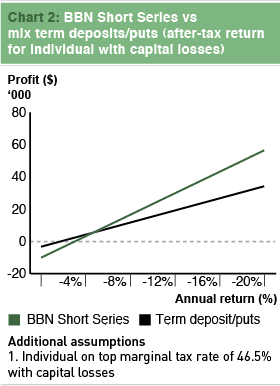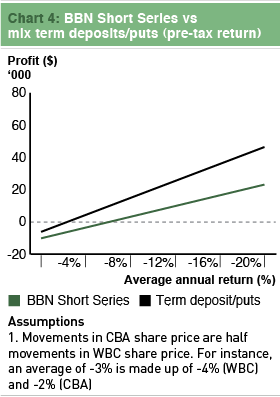BBN Short Bank Series: A bit of a stretch
Key Points
- Will have some appeal to a select crowd
- Pitch is attractive but the terms much less so
- Better, more flexible, cheaper ways of punting on the same outcome
The Product
The snappily-named BBN Short Bank Series 1 Deferred Purchase Agreements (DPAs) is refreshing in many ways. Whilst recent hybrid offers pay an above market coupon as compensation for risks the issuer hopes you won’t notice, BBN Short Bank DPA does the opposite.
Issuers BBN Asset Management and Instreet Investment have designed it as an explicit hedge against a housing market fall and a fragile global economy. It asks investors to sacrifice yield over the short term to ultimately profit if either of these risks prompt a fall in bank share prices.
The product works like a typical capital protected product—for instance, Macquarie Step. Investors pay $100 to buy a DPA unit. The issuer guarantees to repay $90 of the investment on maturity in three and a half years, together with any negative performance on the linked shares (Commonwealth Bank (CBA) and Westpac (WBC)). Investors are effectively ‘short’ the shares in these banks.
Like Step, this DPA is an unleveraged product. There are no prepaid interest deductions to muddy the waters. It’s an outright punt on the performance (or lack thereof) of CBA and WBC over the next three and a half years, although not quite as simple as it seems.
It’s satisfying to see a product manufacturer come up with a structured product that caters to a genuine investor need. But BBN has its work cut out trying to sell it. Right now, retail investors are more interested in being paid to disregard risk than paying to insure against it.
As with other capital protected products, BBN Short Bank DPA offers the opportunity to receive any profit in the form of capital gains, which will be attractive to those with capital losses or investors taking advantage of a lower CGT rate. But the big question is whether the product does what it claims.
The Proposition
The marketing brochure outlines the case:
‘We propose a medium term position against the banks effectively hedging potential house price falls and weakness in the global markets. We have identified Australian bank share prices as the relevant proxy and have developed a strategy to benefit from lower prices’.
In the event of widespread falls in house prices, or further global weakness, Australian bank shares will almost certainly come under selling pressure. Large price falls may well follow. Should that occur, this product would pay a performance amount to investors in addition to the guaranteed $90.
Note that there is a ‘participation rate’ that applies to the performance amount, set based on market conditions at the issue date. It’s estimated you’ll get between 90% and 105% of the negative performance, although the calculation itself is quite unusual (more on this later).
The devil in the detail
So, are these potential returns sufficient to justify the investment?
There are a number of considerations. First, while there might be some correlation between bank share prices and house prices, that doesn’t mean one is a proxy for the other. House prices have to fall by a significant amount—generally 20% or more—and the borrowers need to go broke before the banks wear losses (although the losses could kick in earlier in the event mortgage insurers were unable to pay out on claims). Furthermore, residential mortgages aren’t a bank’s only asset or business. It is tough to see any other businesses ‘saving’ the share price but they might dampen its fall.
It’s the extent of the losses that will probably determine whether bank shares fall significantly. Falling house prices, combined with foreign investors pulling out of Australia, could be ugly for bank share prices but a generally weak market may not trigger the falls required to make this product worthwhile.
Second, it’s one thing to be bearish on residential property (as is your author) but quite another to bet against it over a fixed time frame. BBN Short Series DPA requires you to do just that. It’s also quite possible that the threat of a serious housing market crash would be ameliorated by Government action, as we saw with the two versions of the First Home Buyers Grants, and a loosening of monetary policy.
Indeed, there’s a reasonable chance the Government would put Australia’s sovereign credit rating on the line rather than let the banks go into freefall. Government intervention may ultimately fail but it’s not something on which we’d like to bet occurring within the three and a half year duration of this product.
Finally, while the product is called the ‘Short Bank Series’ and the performance payout is linked to CBA and WBC, it’s not quite what it sounds. It’s really the equivalent of an exotic put option over CBA and WBC, a ‘best-of put option’ in fact. This style of option is exercised against the best performing share in a basket rather than the worst performer, or the overall basket. Similarly, this product’s performance component is based on the negative return of the best performing share of the two.
Let’s decipher that for you. If Westpac shares were to collapse and CBA shares to remain flat, this product would pay you nothing. Oh dear. A genuine house price collapse would quickly reveal which bank faced the deepest problems, and yet your performance payment will be calculated using the figure of the bank least exposed.
As we saw in the GFC when Commonwealth Bank picked up BankWest for a song, a crisis may even strengthen the position of some banks. So, you might pick the big loser in the crisis (say Westpac) but that won’t help you one iota if CBA is the big winner, and vice versa.
Performance Comparisons
The Product Disclosure Statement (PDS) says you need to receive a 10% performance amount to break-even but, unless you have a penchant for non-interest bearing term deposits, this isn’t quite correct. Had you invested $100 in a term deposit, you really need to reach about $118 to break-even on a pre-tax basis—a 28% performance component (or, in other words, the best performing share falling by 8% per annum).
Table 1 shows the pre-tax performance of BBN Short Bank DPA versus an investment in term deposits and put options over CBA and WBC. Best-of puts don’t trade on the ASX, so we’ve assumed vanilla put options are purchased instead (50% on each). Assuming CBA and WBC shares fall by equal amounts, this product has a similar pay-off profile to our alternative investment—with lower profit amounts, largely a reflection of the lack of interest income on the BBN product.
But, as we saw in Capital protected products: Will the tax benefits save you?, the tax characteristics of the investor can have a major bearing on the final analysis. In Table 2 we show the ‘best case’ scenario—a top marginal tax rate individual with capital losses. In this case, the tax benefit of the BBN Short Bank DPA starts to pay off once annual performance is below minus 5%. Table 3 shows the after-tax analysis for a SMSF with capital losses.
The more interesting (and relevant) analysis comes if we assume the shares fall by different amounts—for instance, when WBC falls twice as much as CBA. Table 4 shows the pre-tax comparison of the two investments. As you can see, the performance is now miles apart. Even with the tax benefits (for an individual with capital losses) included, the BBN Short Bank DPA can’t make up for the lack of performance arising from the ‘best of’ nature of the option embedded in it.
More food for thought
This product may get a tick for effort but the investment case doesn’t stack up. For these reasons, it’s not something we can recommend. If, however, you’re considering a dabble, consider the following:
-
Fees. 3% upfront, a flat arranging fee, an unspecified spread on the hedging arrangements and additional fees that might be paid by the investment bank providing the hedge—either to BBN, your financial adviser or both. Nice work if you can get it. No wonder they can’t afford a vanilla put option.
-
Timing and liquidity. Like other structured products—for instance, Macquarie Flexi and Macquarie Step—your investment date and maturity date are set in stone. Plus, it is illiquid. Yes, you get a semi-annual buyback option but that requires you to wear early break costs (including all those fees).
-
Counterparty risk. With this product you’re punting on the collapse of big bank share prices and relying on the investment bank providing the hedge being able to cough up. To a lesser extent, you’re also relying on BBN and Instreet surviving a bank meltdown. This is a glaring weakness of this product versus, say, ASX listed put options (where you are dealing with the central exchange).
-
Early termination. Generally this is a low risk but, again, the nature of this product brings it into play. There is greater risk in these circumstances of a ‘market disruption event’, which could allow the hedge counterparty to terminate early. It’s likely you would still make a profit in these circumstances, but it could be curtailed.
- Tax. This product doesn’t have an ATO Product Ruling, which increases the risk of the tax man challenging the treatment. The tax aspects of this product are a well-worn path, so it’s not a big concern. Just be sure to read the tax opinion in Section 8 of the PDS clearly—especially the part that says if you intend to use the agency sale facility, any profit might not be a capital gain—and seek professional tax advice if you are at all unsure.
Finally, given the costs of the product, and the potential for external factors—in particular, Government intervention and the possibility of a ‘winner’ from the crisis—to affect the performance payoff, investors keen to benefit from a house price collapse might consider alternative strategies.
Shorting the ASX200 (either through a CFD account or buying puts), or a selected portfolio of shares—for instance, banks, property trusts and manufacturers—is likely to be cheaper in some cases, allow you to control the term of your investment and give a payoff that is less exposed to erratic outcomes. Politicians may be able to keep a fall in a particular bank’s shares at bay but they can’t control the broader market.
This is not a strategy we’d recommend as a house price collapse may take many forms—long and drawn out over many years being one of the more likely. And it may never happen at all. But if you are keen on the idea behind this product, these alternatives are food for thought.
Verdict
The ‘short house prices’ pitch may find a niche appeal, as should a product that offers the opportunity to profit from falling house prices. Unfortunately, BBN Short Bank DPA isn’t quite that product.











